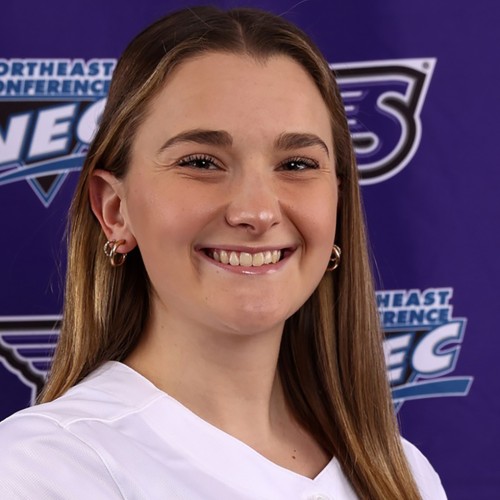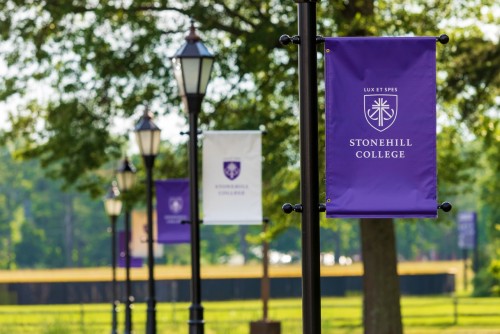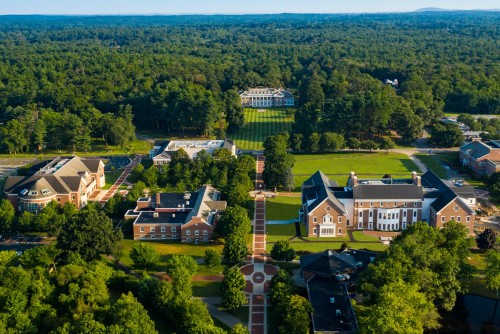An Undergrad Neuroscience Program with Graduate-Level Benefits
Research opportunities and ability to pursue Bachelor of Arts or Bachelor of Science, allow students to tailor their degree to suit their goals.
You’d expect someone who has wanted to be a scientist since ninth grade to be laser focused on data during the college search process. Neuroscience major Nicole Teaney ’21 definitely took that approach in determining that Stonehill’s program was top notch. But in the end, it was love that swayed her — love strong enough to bring her search to an abrupt stop.
“I fell in love the minute I stepped on the campus,” Teaney said. Later that day, she and her mother were headed to another school Teaney was interested in — an Ivy League college in the area that also offers a neuroscience degree. But she told her mom to stop the car and go back to Stonehill. “It already felt like home,” said Teaney, who now works as a research assistant at Boston Children’s Hospital.
And once she started taking classes in the Neuroscience Program, she knew her gut feeling had been the right one. “Right away, I was in awe of the faculty support and one-on-one collaboration with professors,” Teaney said. “They cheer you on and support you every step of the way.” And with a neuroscience major, “the way” can have a wide array of meanings.
Many graduates of the neuroscience program go on to become doctors and scientists. Others use the degree to pursue counseling, psychology and other professions.
Professor Nicole Cyr, director of the neuroscience program, said this diversity of outcomes reflects the way the program is set up. Unlike students in similar programs at other colleges, Stonehill students interested in neuroscience have myriad options because the college offers both Bachelor of Arts and Bachelor of Science degrees.
“Most small schools offer a B.A.; most big schools offer a B.S.,” Cyr explained. “The students who are going on to the medical professions, to be M.D.s or P.A.s — all the acronyms — can go for the B.S. and get the strong science background that they need.” But students who are more interested in how neuroscience intersects with psychology or philosophy or data science or artificial intelligence would be better served by a B.A.
That level of flexibility is evident — and exciting — to Cyr’s students. Isabella Therrien ’25, a transfer student and student-athlete on the softball team, said that it set Stonehill’s neuroscience program apart when she was deciding where to transfer.
Whatever type of career you want to go into, there are endless job possibilities, endless research possibilities, endless goals you can pursue and Stonehill’s professors are there to help make it happen for you.
“Whatever type of career you want to go into, there are endless job possibilities, endless research possibilities, endless goals you can pursue,” Therrien said — and Stonehill’s professors are there to help make it happen for you. “I’ve never met somebody in the neuroscience program who knew what they wanted to do and couldn’t find a professor who was involved in it.”
Cyr said that the program is designed to offer that level of faculty support as soon as students arrive on campus. “We talk to our students straight on,” she said. “We have meetings the first week they’re here and then at least twice more each year.” The meetings don’t just cover the courses they’re going to take, but also what direction they want their career to go in. “That leads directly to research and internship opportunities,” she said.
To have numerous research opportunities at such an early point in a student’s career is rare. “Finding a full-time research opportunity as an undergrad at a bigger school is really hard,” Teaney said. “You’re competing against grad students.” Stonehill, on the other hand, encourages its undergraduates to apply for positions in their labs.
In fact, Therrien said, “I have such a strong relationship with my professors that they came to me and asked if I wanted to do research with them. We don’t have to chase them or beg them to give us a chance.”
Molly Quattrucci ’23 is a research assistant at a lab at Brigham and Women’s Hospital, conducting multiple sclerosis research.
That research experience sets Stonehill students up for uncommon success. Molly Quattrucci ’23 is a research assistant at a lab at Brigham and Women’s Hospital, conducting multiple sclerosis research. “When I applied, I was up against people from Harvard and Boston University and Northeastern University,” Quattrucci said. “Having already conducted research helped me stand out. Not a lot of schools offer that.”
“At a bigger school,” Cyr said, “you might be in a fancy lab with high-tech equipment — but they wouldn’t let you touch it! And you’d be working with grad students or postgrads. At Stonehill, you’re working with a professor. I work with all the students and teach them personally.” And at the end of their research, students go with Cyr to the NEURON Conference and present their own work.
“You really get to learn what it would be like to do this work full time,” Cyr said. “The students leave with a good sense of whether they want to pursue this career.”
Teaney couldn’t have known any of that when she told her mother to turn the car around and go back to Stonehill. But now, a few years into a promising career, she can be sure she made the right decision.
“What I learned in the Neuroscience Program has equipped me to be a scientist today,” Teaney said. “If it wasn’t for those classes and those professors, I wouldn’t be as successful as I am now.”
-
Request Information
Sign up now to be added to our mailing list, and we will show you how Stonehill could become part of your story.
-
Visit Opportunities
Our visit programs will help give you a better understanding of how Stonehill’s expansive leadership and experiential learning opportunities equip students for success in a rapidly evolving and globally competitive world.
-
Apply for Admission
Stonehill College provides an exceptional learning experience for both undergraduate and graduate students. We invite you to review the process, requirements and application deadlines for our entry options.



